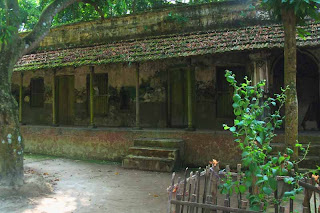Built in 1853, following the acquisition of tax collection rights by Govinda Roy Chowdhury, a grocer, Govinda Bhavan is one of the earliest of the remaining Zaminderbari of Bangladesh.
Presumeably acquiring the office, that would have been sold at auction by the Honourable East India Company, who , at the time, still controlled the administration of what was then Bengal... though 5 years later, following the ‘Indian Mutiny’, now more often referred to as the First Indian War of Independence, or the Sepoys rebellion... with either the profits from his business, or with loans that also financed the building of such a suitably impressive residence before the tax revenues began to flow, since he had six sons the palace was constructed with six pavilions.
Stylistically, Govinda Bhavan seems to have most in common with Teota Palace on the banks of the Padma River in Manikganj, which was roughly contemporary, and another survivor of the 1897 Great India Earthquake that necessitated the reconstruction of so many of the great buildings of the region.
This residence, still occupied by the family of Zaminders, offers something of a picture of life in such great houses, with different branches of the family occupying different parts.
Here, you can begin to understand the lives lived by these factors of the Company, and later the Raj, who, unlike most of India, were men of business rather than hereditary royalty.
In the 1930s, a great wedding took place..well, two weddings in fact, on the same day, on the same river. Two sons of the last Zaminder married. The elder, the daughter of the Zaminder of Balliatti Palace, a mere 9km away by river. A younger, the daughter of the last Zaminder of Kutcheri Bhavan, in Tangail. Each Zaminder too proud to concede to another the hosting of the marriages, they were held on a boat on the river!
The glimpse of a world that once was in Bangladesh is sometimes hard to reconcile with the life of this country today. The conspicuous wealth of those times was more lavish, even, than that of today’s businessmen of the country, apparently with more in common with country house life in the UK, with which they were undoubtedly familiar from the visits and university stays made in Britain by the scions of these, then, great families.
A fascinating place so close to Dhaka, for such a glimpse of the past.







No comments:
Post a Comment